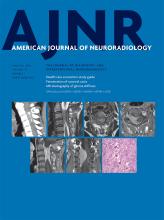Index by author
Popielski, J.
- FELLOWS' JOURNAL CLUBInterventionalYou have accessTwo-Center Experience in the Endovascular Treatment of Ruptured and Unruptured Intracranial Aneurysms Using the WEB Device: A Retrospective AnalysisJ. Popielski, A. Berlis, W. Weber and S. FischerAmerican Journal of Neuroradiology January 2018, 39 (1) 111-117; DOI: https://doi.org/10.3174/ajnr.A5413
The authors performed a retrospective analysis of all ruptured and unruptured aneurysms treated with a WEB device between August 2014 and February 2017. Primary outcome measures included the feasibility of implantation and the angiographic outcome. Secondary outcome measures included the clinical outcome at discharge and procedural complications. One hundred two aneurysms in 101 patients, including 37 (36.3%) ruptured aneurysms, were treated with the WEB device. Implantation was successful in 98 (96.1%) aneurysms. Additional devices (stents/coils) were necessary in 15.3% (15/98) of aneurysms. Delayed aneurysm ruptures have not been observed during the follow-up period to date. They conclude that the WEB device offers a safe and effective treatment option for broad-based intracranial aneurysms without the need for dual antiplatelet therapy.
Poppe, A.Y.
- InterventionalOpen AccessTime for a Time Window Extension: Insights from Late Presenters in the ESCAPE TrialJ.W. Evans, B.R. Graham, P. Pordeli, F.S. Al-Ajlan, R. Willinsky, W.J. Montanera, J.L. Rempel, A. Shuaib, P. Brennan, D. Williams, D. Roy, A.Y. Poppe, T.G. Jovin, T. Devlin, B.W. Baxter, T. Krings, F.L. Silver, D.F. Frei, C. Fanale, D. Tampieri, J. Teitelbaum, D. Iancu, J. Shankar, P.A. Barber, A.M. Demchuk, M. Goyal, M.D. Hill and B.K. Menon for the ESCAPE Trial InvestigatorsAmerican Journal of Neuroradiology January 2018, 39 (1) 102-106; DOI: https://doi.org/10.3174/ajnr.A5462
Poptani, H.
- EDITOR'S CHOICEHead and Neck ImagingOpen AccessDynamic Contrast-Enhanced MRI–Derived Intracellular Water Lifetime (τi): A Prognostic Marker for Patients with Head and Neck Squamous Cell CarcinomasS. Chawla, L.A. Loevner, S.G. Kim, W.-T. Hwang, S. Wang, G. Verma, S. Mohan, V. LiVolsi, H. Quon and H. PoptaniAmerican Journal of Neuroradiology January 2018, 39 (1) 138-144; DOI: https://doi.org/10.3174/ajnr.A5440
The authors evaluated 60 patients with dynamic contrast-enhanced MR imaging before treatment. Median, mean intracellular water molecule lifetime, and volume transfer constant values from metastatic nodes were computed from each patient. Kaplan-Meier analyses were performed to associate mean intracellular water molecule lifetime and volume transfer constant and their combination with overall survival and beyond. Patients with high mean intracellular water molecule lifetime had overall survival significantly prolonged by 5 years compared with those with low mean intracellular water molecule lifetime. Patients with high mean intracellular water molecule lifetime had significantly longer overall survival at long-term duration than those with low mean intracellular water molecule lifetime. Volume transfer constant was a significant predictor for only the 5-year follow-up period. They conclude that a combined analysis of mean intracellular water molecule lifetime and volume transfer constant provided the best model to predict overall survival in patients with squamous cell carcinomas of the head and neck.
Pordeli, P.
- InterventionalOpen AccessTime for a Time Window Extension: Insights from Late Presenters in the ESCAPE TrialJ.W. Evans, B.R. Graham, P. Pordeli, F.S. Al-Ajlan, R. Willinsky, W.J. Montanera, J.L. Rempel, A. Shuaib, P. Brennan, D. Williams, D. Roy, A.Y. Poppe, T.G. Jovin, T. Devlin, B.W. Baxter, T. Krings, F.L. Silver, D.F. Frei, C. Fanale, D. Tampieri, J. Teitelbaum, D. Iancu, J. Shankar, P.A. Barber, A.M. Demchuk, M. Goyal, M.D. Hill and B.K. Menon for the ESCAPE Trial InvestigatorsAmerican Journal of Neuroradiology January 2018, 39 (1) 102-106; DOI: https://doi.org/10.3174/ajnr.A5462
Pradat, P.-F.
- Spine Imaging and Spine Image-Guided InterventionsOpen AccessSpinal Cord Gray Matter Atrophy in Amyotrophic Lateral SclerosisM.-Ê. Paquin, M.M. El Mendili, C. Gros, S.M. Dupont, J. Cohen-Adad and P.-F. PradatAmerican Journal of Neuroradiology January 2018, 39 (1) 184-192; DOI: https://doi.org/10.3174/ajnr.A5427








